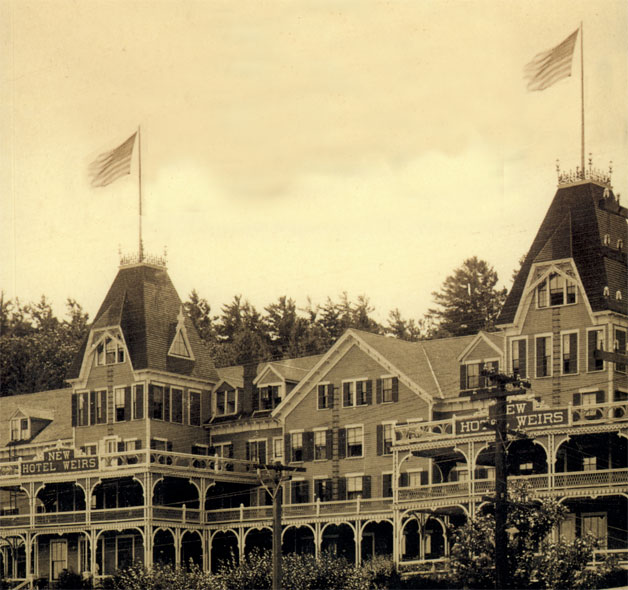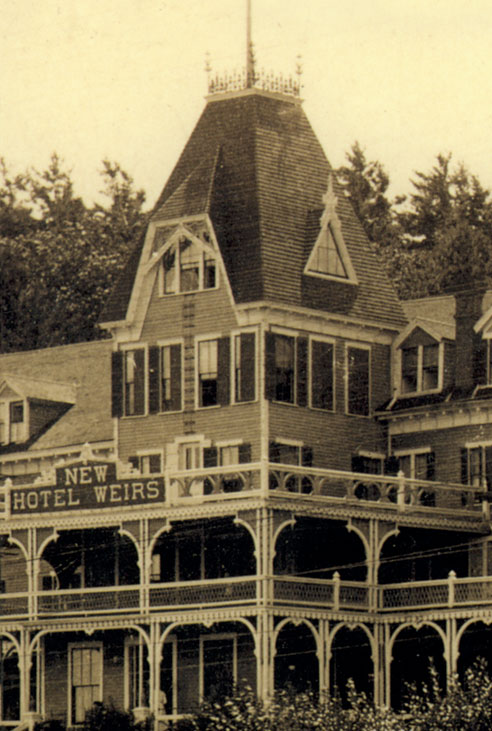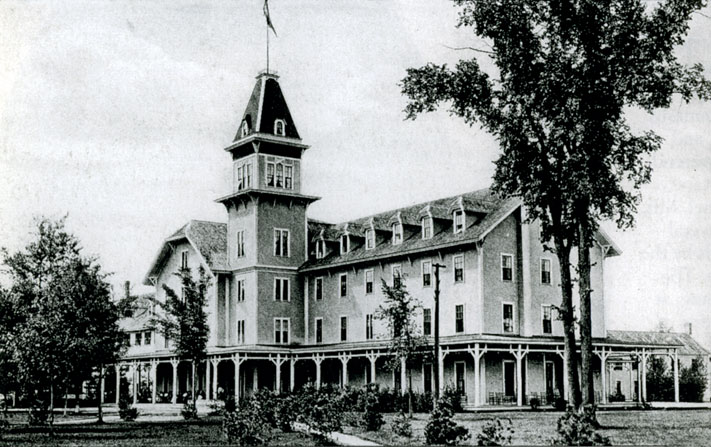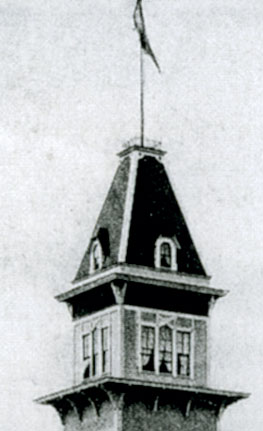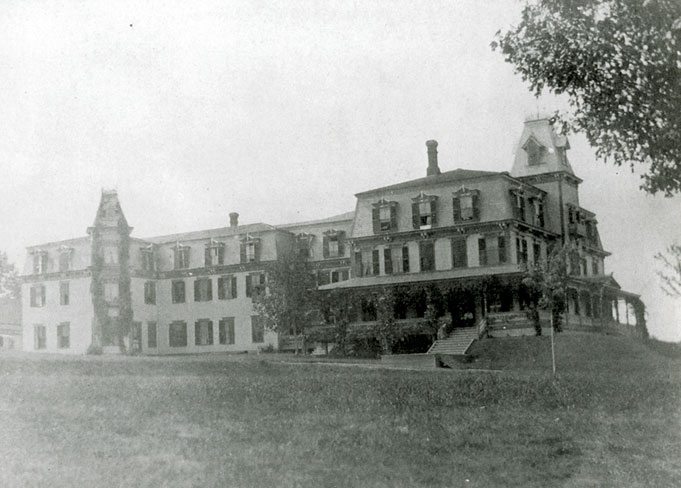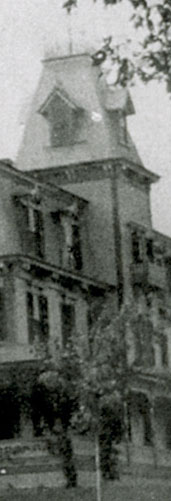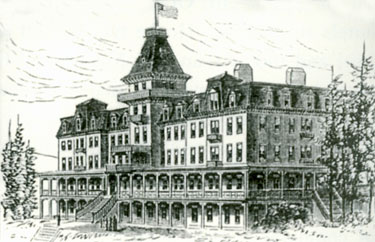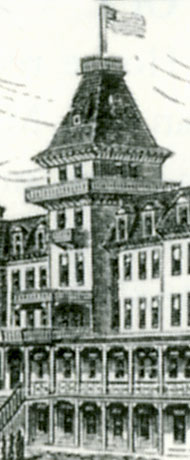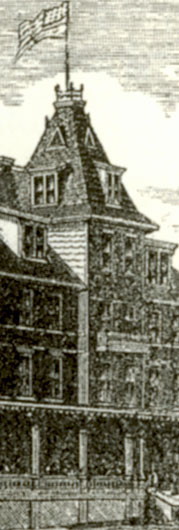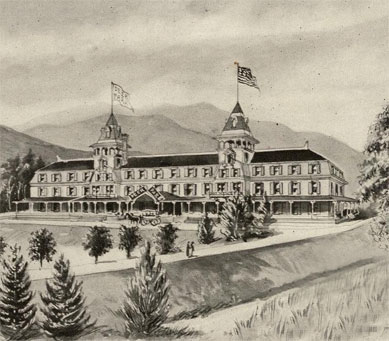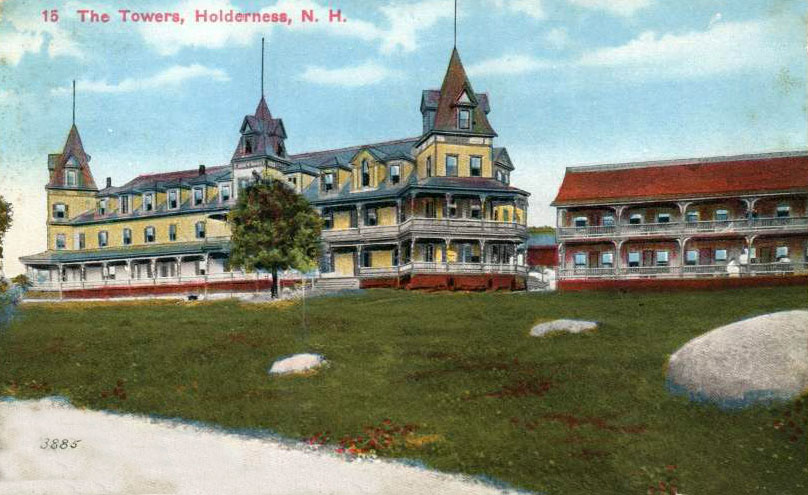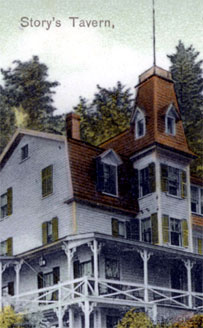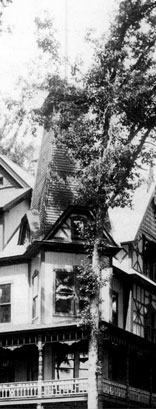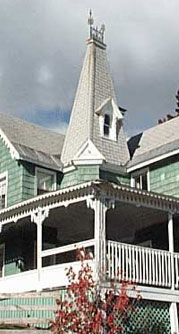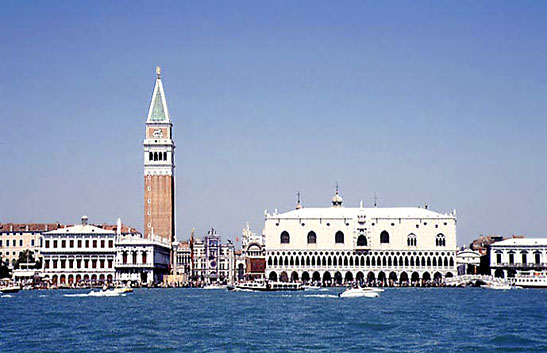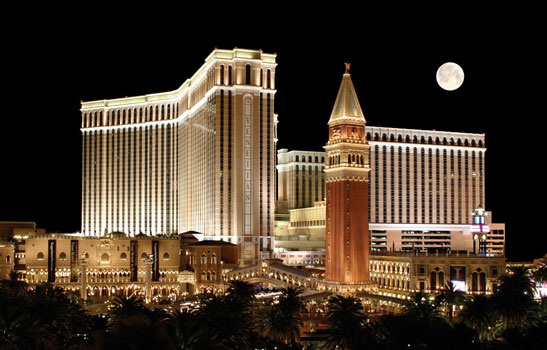Hotel Weirs Architecture
Designed in 1880 by A.L. Davis, who also designed the second, 1880-1892 train station, the New Hotel Weirs was 3 1/2 stories high, and massed 300′ horizontally along a north-south axis, with its front elevation facing the Lake. It was of typical wooden clapboard construction. Its design was inspired by two architectural styles that were very popular at the time: Queen Anne, and Italian Revival, also known as Italianate.
Its most conspicuous architectural element were its twin, off-center, square towers. The towers extended an additional story above the main building and projected frontally from the main building . The towers were surrounded by triple-tiered verandas, and were topped with cut-off pyramidal turrets. Each turret was topped by an observatory box, wrought iron cresting, and a flagpole. Each turret featured crested triangular dormers on the back, left, and right sides, each with a six-paned, triangular window. On the front, each turret featured an isosceles trapezoidal dormer. The trapezoidal dormer had a steeply pitched shed roof, an inverted, v-shaped lintel over a conventional triple window, gingerbread lace trim, and an emergency fire ladder to the 3rd tier veranda.
Between the two towers and in the center of the Hotel was a cross gable that projected frontally from the main building but not as far forward as the two towers. It featured an emergency ladder to the 2nd tier veranda.
Visually tying together the two towers, cross gable, and main structure, were identical, modillioned brackets under the roof eaves.
Giving the Hotel much of its character, and providing another unifying element, were the spacious verandas or piazzas, which ran along the entire front length of the structure, seamlessy joining the veranda tiers around the two towers on the first and second levels, but not on the third level. The first tier, which was covered, had simple, diagonal cross-braced railing. The second tier, which was only covered where it wrapped around the two towers, had latticed railing. The third, uncovered tier around the towers had decorative, fleur-de-lis railings.
Between each set of dual posts holding up the veranda roof coverings on both the first and second levels were ornamental arches. On the first level, these arches were simple, with empty spandrels and an inverted bell shape at the apex. On the second level around the towers, the arches were more elaborate. Between the dual posts themselves, a filler board was punctuated by a series of round holes, while the spandrels were filled in with vertical sticking and the arches were cut off with end-arrow points at each side of the arch gap. Both the first and second level veranda roof rakes were trimmed with bargeboard, but each level had its own distinctive style.
Regarding the fenestration, almost all the windows were of the standard double-paned, double hung type flanked by shutters. Almost all the dormers were of the conventional type with double windows and unembellished pediments.
Even though it had been built in four phases, the Hotel was very symmetrical. In addition to the twin towers, on the far left and far right of the front of the Hotel on the 2nd level were matching semi-circular bay windows that faced the Lake. On the two longitudanal sides of the Hotel, there were small balconies at the hall ends of the 2nd and 3rd floors. The symmetricality even extended to matching signage on the two towers, and to matching retail outbuildings on the left and right front corners of the Hotel block.
There were some exceptions to this symmetricality, however, mostly attributable to the intial, first phase of construction, when the left tower had been built. At that time an ell was built which extended rearward. This was the only ell ever built. As the building was expanded, it expanded along its main north-south axis, and no further perpendicular appendages were added. Although there were several outbuildings built in the rear, they were unattached to the main structure.
The left tower served as the lobby to the Hotel, and was reached by a wide grand stairway that folded up the hill. There was no comparable stairway to the right tower; however, the far right side of the Hotel did feature a modest, L-shaped stairway descending from the veranda to Tower Street.
Other non-sysmetrical features were far less noticeable. The left tower had a 3rd floor door in its front center leading out to the wrap-around deck; while the right tower’s door to the 3rd floor deck was located on the left or right side of the tower, not in its front center. The left tower also sported flanking chimneys while the right tower had none.
Of all the building elements heretofore mentioned, it was the twin towers that were the dominant sylistic expression of the building. The original tower may have possibly been inspired by the Kearsarge House in North Conway, whose tower was built in 1871-1872. Other notable nearby hotels featuring pyramidal towers include: the Towers, in Holderness; the Maplewood Hotel, Bethlehem, which opened in 1876; the Uplands, also Bethlehem, opened 1880; the Forest Hills Hotel, Franconia, opened 1883; the 2nd Lancaster House, opened in 1881-1882; and the Deer Park Hotel, North Woodstock, opened in 1887.
The Kearsarge House and Tower, North Conway (Built 1861 – Burned 1917)
The Uplands Hotel and Tower, Bethlehem (Built 1880 – Razed 1990)
The Forest Hills Hotel and Tower, Franconia (Built 1883 – Razed 1984)
The Lancaster Hotel and Tower (Built 1882 – Burnt March 31, 1954)
The Deer Park Hotel and Tower, North Woodstock (Built 1887 – Burnt June 23, 1952)
In Weirs Beach, other buildings with turrets that shared the dormered, cut-off, pyramidal design include: Story’s Tavern; the National Veterans Association building at the NHVA; and Romeo’s Balcony. Only Romeo’s Balcony still exists today. Of course its turret is much smaller in scale than the Hotel Weirs, but it is of similar design.
Perhaps the best known, and largest, example of the cut-off pyramidal tower design today, is the Campanile di San Marco tower in Venice, and its reproduction at the Venetian Hotel in Las Vegas.
This article is by the webmaster and was written on December 14, 2008. The article was inspired and informed by Bryant F. Tolles 1998 book, The Grand Resort Hotels of the White Mountains, A Vanishing Architectural Legacy, published by David R.Godine, Boston. Other information sources: Railways and Waterways Through the White Mountains by Bruce D. Heald; The White Mountains by Randall H. Bennett; and White Mountain Hotels, Inns, and Taverns by David Emerson. All Arcadia publishing.
Graphic sources: New Hotel Weirs – from The Weirs (cover), by Warren Huse
Kearsarge House, Uplands Hotel – From Bennett’s book
The Maplewood, Forest Hills, and Lancaster hotels – From Tolles’ book
The Deer Park Hotel – from the David Rumsey Map collection
Story’s Tavern, the National Veterans Association building, Romeo’s Balcony – from the Webmaster’s collection
Campanile di San Marco – Stephen Edelbroich
The Venetian – from the Venetian website










